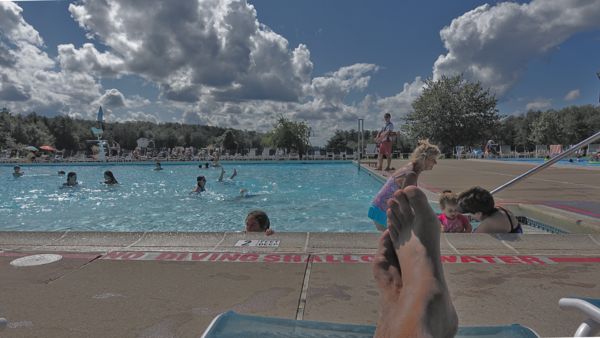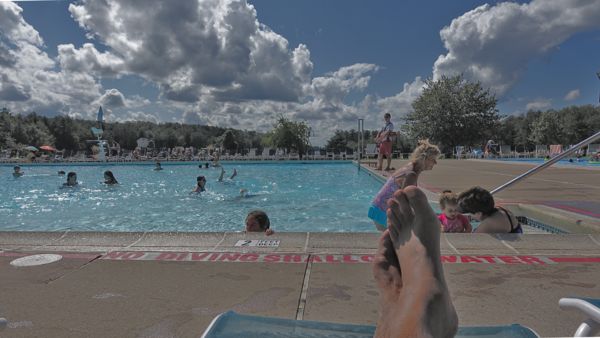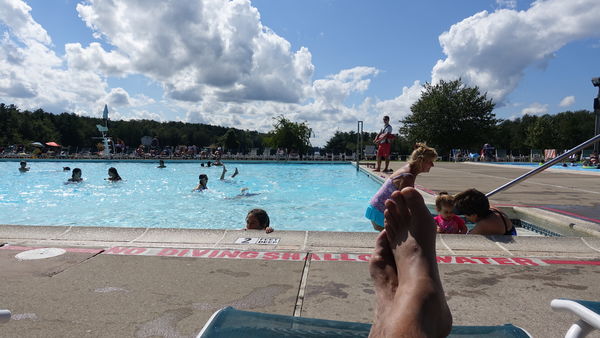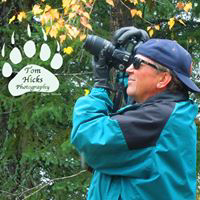Converting Color to B&W
Dec 5, 2018 08:23:02 #
Linda From Maine wrote:
Shoot in color, convert in a robust editor (I use ... (show quote)
Nice photographs! I especially like the repeating geometrical pattern in the second one.
Jason
Dec 5, 2018 08:38:25 #
JasonC wrote:
Thanks! That was shot specifically for b&w. I spent an entire morning trying to "see" in b&w (I was more proficient when I shot b&w film) and composing through my LCD with b&w jpg - while shooting raw also so I could convert in Silver Efex.Nice photographs! I especially like the repeating geometrical pattern in the second one.
Jason
Jason
That was with a Canon T3i. I now have a Panasonic G7 mirrorless that allows me to view the scene in b&w right in the electronic viewfinder - a great feature! Composing for a b&w result is best discussed in a separate topic, though

Dec 5, 2018 08:38:49 #
StevenG
Loc: Long Island, NY
waynetgreen wrote:
Greetings,
I occasionally convert color to BW using Photoshop remove color or desaturate. Results are acceptable but just wondering if there is a distinct advantage to using the monochrome setting in the camera vs post process? Better grey scale maybe? I know I could do some side by side comparisons, but I truly enjoy the comments and expertise of the collective group.
Thanks
I occasionally convert color to BW using Photoshop remove color or desaturate. Results are acceptable but just wondering if there is a distinct advantage to using the monochrome setting in the camera vs post process? Better grey scale maybe? I know I could do some side by side comparisons, but I truly enjoy the comments and expertise of the collective group.
Thanks
Shoot in color, convert in post processing. Try Topaz and ON1. Both have extensive options that I find work nicely.
Steve
Dec 5, 2018 08:53:48 #
Photocraig wrote:
I agree, if you are a Canon user, shoot RAW + JPEG... (show quote)
If you shoot just RAW but choose a B&W style, there will be (for Canon and Nikon) a full embedded image in the RAW file that is accessible by FR and PS. I still shoot both RAW and JPEG for in the field turnaround reasons, but the JPEG is not absolutely necessary since the adjustments are noted in the RAW file already.
Dec 5, 2018 08:54:13 #
Converting a color to B & W in what ever post processing software you use is one thing. But keep in mind that conversion to B & W success depends first on: texture, contrast, patterns, tonal range, lines, shape & form. Not all color images make good B & W images no matter how much post processing you do. Good B & W scenes can be different from good color scenes. Not every color image is born to be B & W. Get it first in the camera, then in post processing. Using NIK Silver Effects Pro - will definitely help you select the ZONE range you want (The same zone range's developed by Ansel Adams).
I would also suggest when converting to B & W - employ the Ansel Adams Printing Plan. Of course you're doing this in digital so it is much easier. After you made your first B & W conversion and adjustments make a print. See what it looks like and then make additional adjustments as you see fit.
I would also suggest when converting to B & W - employ the Ansel Adams Printing Plan. Of course you're doing this in digital so it is much easier. After you made your first B & W conversion and adjustments make a print. See what it looks like and then make additional adjustments as you see fit.
Dec 5, 2018 09:22:49 #
Tomcat5133
Loc: Gladwyne PA
From my research using monochrome setting is not the best way. Shoot color raw and convert in lightroom or one of the good softwares mentioned.
I have been trying to recover for a collection photos and 10 bit video screen grabs to create for print. And looking for composition that is engaging
and studying some of the philosophy of creative photography as an art form. And trying to recover jpgs, video and older studies.
I might not be the only one here that has a history of slides, photos and video that we hope with the new tools we have can make
something of interest and art. The first one is a jpg and the 2nd a tiff. And the last a casual shot taken on location with the RX100 4.
I have been trying to recover for a collection photos and 10 bit video screen grabs to create for print. And looking for composition that is engaging
and studying some of the philosophy of creative photography as an art form. And trying to recover jpgs, video and older studies.
I might not be the only one here that has a history of slides, photos and video that we hope with the new tools we have can make
something of interest and art. The first one is a jpg and the 2nd a tiff. And the last a casual shot taken on location with the RX100 4.



Dec 5, 2018 10:04:10 #
dsmeltz wrote:
Thanks a bunch, appreciate the link, informative
Dec 5, 2018 10:38:27 #
Linda From Maine wrote:
Shoot in color, convert in a robust editor (I use ... (show quote)
I’ve used Nik a lot, but never used the color filters. (Maybe I should 🙀.) But after I come back to PS, I have great control using luminosity masks.
Dec 5, 2018 12:17:47 #
Dec 5, 2018 12:24:39 #
Conversion is what most photographers select. A conversion software like Topaz B&W Effects 2 makes those conversions easier.
Dec 5, 2018 12:27:10 #
rmalarz wrote:
There are numerous methods to convert an image to black and white. My experience has shown that one method doesn't work for every image. I'd familiarize yourself with the various ways to convert to black and white and then try each on an image to achieve the best result. Yes, sometimes just a desaturate works, but at times it's also the worst result.
--Bob
--Bob
...I will sometimes go from one software to another (Nik to Topaz to PS back to Lightroom, maybe a trip into ON1, too!), all powerful tools and the journey is fun, just don't ask me to do it again (part of my routine is, there *is* no routine!). LOL. So, yes, I agree with Bob, there is no holy grail and you need to test/familiarize yourself with the various methods of conversion...so get on the horse and ride, cowboy!
Dec 5, 2018 12:54:00 #
Linda From Maine wrote:
Shoot in color, convert in a robust editor (I use ... (show quote)
Yes - NIK Silver Efex is a broad and useful b&w tool. And I NEVER shoot in monochrome as it seems to suck all the life out of the image and makes pp difficult and burdensome.
Dec 5, 2018 14:02:03 #
There are may ways and many reasons to convert a color image to black and white. How it is done as to method and results depend on what you need to accomplish.
If you want a traditional or accurate gray scale representation of the colors and tones you are going for a PANCHROMATIC interpretation. If for some reason you want to increase the contrast more significantly as in a dramatic portrait, you may go for a more ORTHOCHROMATIC interpretation which would exaggerate the skin texture and darke the red in lips etc.
In digital post processing it is easier to acheive a wide variety of monochromatic interpenetrations from images originally produced in color. In color negative work, special panchromatic papers were required and theses material were not particularly easy to use. Transparencies required the production of inter-negatives which coud also be quite painstaking.
Personally, I prefer to determine, in advance, if I an going to shoot in color or black and white. I have no prejudice for one or the other- some subjects perhaps are more suited for one or the other. On certain assignments, it is not practical to shoot both separately if both are going to be required so the obvious choice is to shoot in color and convert. If I decide or are required to work in black and white I like to pre-visualize in that medium so I set the camer for monochrome or view the scene or subject through a dark green filter to get a better idea of the tonal scale and relationships. I lie to use color filters, in certain cases to separate tones and produce contrasts where certain differet colors may register in the same tone of gray id left unfiltered.
In portraiture, shooting with a ligh yellow or ligh orange filter will create a kinda "porcelain" like skin tone. Shooting with a green filter will dramatize skin textures and mimic the effect of orthochromatic film. Yellow, orange and red filter darken skyscapes.
If you want a traditional or accurate gray scale representation of the colors and tones you are going for a PANCHROMATIC interpretation. If for some reason you want to increase the contrast more significantly as in a dramatic portrait, you may go for a more ORTHOCHROMATIC interpretation which would exaggerate the skin texture and darke the red in lips etc.
In digital post processing it is easier to acheive a wide variety of monochromatic interpenetrations from images originally produced in color. In color negative work, special panchromatic papers were required and theses material were not particularly easy to use. Transparencies required the production of inter-negatives which coud also be quite painstaking.
Personally, I prefer to determine, in advance, if I an going to shoot in color or black and white. I have no prejudice for one or the other- some subjects perhaps are more suited for one or the other. On certain assignments, it is not practical to shoot both separately if both are going to be required so the obvious choice is to shoot in color and convert. If I decide or are required to work in black and white I like to pre-visualize in that medium so I set the camer for monochrome or view the scene or subject through a dark green filter to get a better idea of the tonal scale and relationships. I lie to use color filters, in certain cases to separate tones and produce contrasts where certain differet colors may register in the same tone of gray id left unfiltered.
In portraiture, shooting with a ligh yellow or ligh orange filter will create a kinda "porcelain" like skin tone. Shooting with a green filter will dramatize skin textures and mimic the effect of orthochromatic film. Yellow, orange and red filter darken skyscapes.
Dec 5, 2018 22:32:33 #
Tom Daniels wrote:
From my research using monochrome setting is not t... (show quote)
Tom, I am having a little trouble trying to understand what your three photos have to do with B&W.
Dec 6, 2018 02:56:14 #
waynetgreen wrote:
Greetings,
I occasionally convert color to BW using Photoshop remove color or desaturate. Results are acceptable but just wondering if there is a distinct advantage to using the monochrome setting in the camera vs post process? Better grey scale maybe? I know I could do some side by side comparisons, but I truly enjoy the comments and expertise of the collective group.
Thanks
I occasionally convert color to BW using Photoshop remove color or desaturate. Results are acceptable but just wondering if there is a distinct advantage to using the monochrome setting in the camera vs post process? Better grey scale maybe? I know I could do some side by side comparisons, but I truly enjoy the comments and expertise of the collective group.
Thanks
Just for completeness: no matter what you do to an image produced by a color sensor,
color sensors have different charactersitics than monochorme sensors. The result is
a decolorized color image, not the image a monochrome sensor would have taken.
Sometimes that won't matter; sometimes it will.
The distinction is important, because monochrome sensors are more sensitive, higher resolution,
greater dynamic range and lower noise than a comperable color sensor. That's because color sensors
use colored filters, and it takes 3 photocells to produce 1 color pixel. But on a monochrome sensor,
there are no colored filters and 1 photocell = 1 pixel. That's why monochrome sensors are common
in high-end outdoor security cameras.
The situation is analogous with film: you pay price for shooting in color. Color slide film is a lot
less forgiving than B&W print film--since color film also has colored filter layers.
If you want to reply, then register here. Registration is free and your account is created instantly, so you can post right away.











